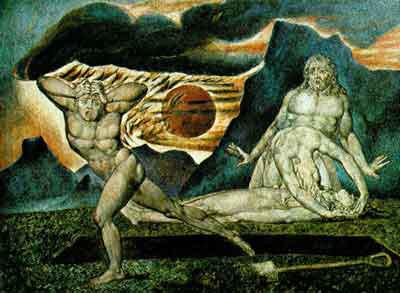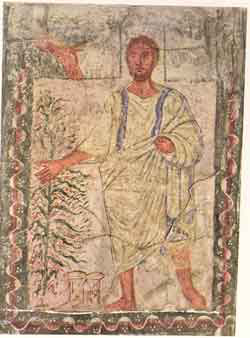This narrative is characterized by gaps, silences and fateful unexplained actions that provoke more questions than solutions. Both literary and visual commentators have tried to fill these gaps and answer the important questions.
The description is bare bones: not a word on physical appearance, few emotions.
(א) וְהָ֣אָדָ֔ם יָדַ֖ע אֶת־חַוָּ֣ה אִשְׁתּ֑וֹ וַתַּ֙הַר֙ וַתֵּ֣לֶד אֶת־קַ֔יִן וַתֹּ֕אמֶר קָנִ֥יתִי אִ֖ישׁ אֶת־יהוה׃ (ב) וַתֹּ֣סֶף לָלֶ֔דֶת אֶת־אָחִ֖יו אֶת־הָ֑בֶל וַֽיְהִי־הֶ֙בֶל֙ רֹ֣עֵה צֹ֔אן וְקַ֕יִן הָיָ֖ה עֹבֵ֥ד אֲדָמָֽה׃
(1) Now the Human knew his wife Eve, and she conceived and bore Cain, saying, “I have gained a person with the help of יהוה.” (2) She then bore his brother Abel. Abel became a keeper of sheep, and Cain became a tiller of the soil.
Exegetical problems continue to abound. Cain says something to his brother, but what he says is missing from the text. Did Cain plan to kill his brother or was he provoked into an unintended outburst? God interrogates the hypocritical murderer and condemns Cain to perpetual exile. In verse 13, Cain cries out three ambiguous words.
The 12th century Sepharadi exegete, Abraham Ibn Ezra, writes that the word avon can mean either 'sin' or 'punishment', both part of a single process. Thus one understanding of Cain's words is as a protest against his punishment. In response, God reduces Cain's punishment by placing on him a mark of protection. Rashi, Ibn Ezra's Ashkenazi predecessor, understands Cain's words as a question: Is my avon indeed too much to bear? Thus Cain is begging for mercy, by reminding God of His previous (midrashic) acts of mercy. The 13th century Sepharadi commentator, Ramban, insists that the correct understanding of the Cain's words is as a confession: Indeed, my crime cannot be forgiven. We conclude that human contrition can prevent Divine condemnation - a prophetic concept generally lacking in the Torah.
Finally, a sign or mark of some sort is put on Cain - what does this mark look like? What does this sign (that has become a stock phrase in western, as well as in modern Hebrew parlance) do?
To sum up: the biblical story of Cain and Abel is characterized by ambiguity and gaps that the lay reader and the theologian must fill, according to their inclination and imagination.
In order to begin to unpack the artistic answers to the many questions raised by the biblical account, we will first examine a work that illustrates all stages of the plot: a bronze relief produced for the doors of the Baptistery of Florence's main cathedral in 1424, by the Italian artist Lorenzo Ghiberti.
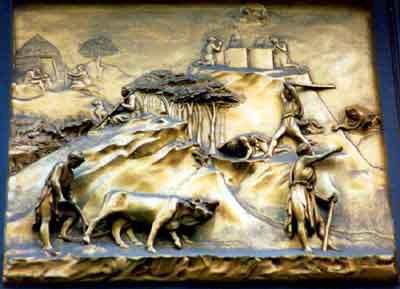
Comparison of Ghiberti's treatment to that of other artists reveals that few others relate to the exposition found in the first act. Most artists are interested mainly in the offerings and the murder, and somewhat less in the expulsion. If so, why did Ghiberti choose to pay so much attention to background, which even the Bible limits (2 verses)? It appears that Ghiberti's intention was to emphasize the horror of the murder by contrasting it to the pastoral atmosphere of the first act, the point of reversal coming with the rejection of Cain's offering. The contrast is also expressed in the transformation of Abel's staff, from the scene of his watch over his flock to Cain's murder weapon, still in his hands as he is banished by God. The meaning of God's and Cain's gestures in this last scene is unclear: Is Cain rejecting responsibility for his brother's welfare (Am I my brother's keeper?) or is he begging for divine reprieve?
Artists, like literary commentators, expressed their own and their culture's interpretations of our story.
(ג) וַֽיְהִ֖י מִקֵּ֣ץ יָמִ֑ים וַיָּבֵ֨א קַ֜יִן מִפְּרִ֧י הָֽאֲדָמָ֛ה מִנְחָ֖ה לַֽיהוה׃ (ד) וְהֶ֨בֶל הֵבִ֥יא גַם־ה֛וּא מִבְּכֹר֥וֹת צֹאנ֖וֹ וּמֵֽחֶלְבֵהֶ֑ן וַיִּ֣שַׁע יהוה אֶל־הֶ֖בֶל וְאֶל־מִנְחָתֽוֹ׃ (ה) וְאֶל־הַ֥יִן וְאֶל־מִנְחָת֖וֹ לֹ֣א שָׁעָ֑ה וַיִּ֤חַר לְקַ֙יִן֙ מְאֹ֔ד וַֽיִּפְּל֖וּ פָּנָֽיו׃ (ו) וַיֹּ֥אמֶר יהוה אֶל־הָ֑יִן לָ֚מָּה חָ֣רָה לָ֔ךְ וְלָ֖מָּה נָפְל֥וּ פָנֶֽיךָ׃ (ז) הֲל֤וֹא אִם־תֵּיטִיב֙ שְׂאֵ֔ת וְאִם֙ לֹ֣א תֵיטִ֔יב לַפֶּ֖תַח חַטָּ֣את רֹבֵ֑ץ וְאֵלֶ֙יךָ֙ תְּשׁ֣וּקָת֔וֹ וְאַתָּ֖ה תִּמְשׇׁל־בּֽוֹ׃
(3) In the course of time, Cain brought an offering to יהוה from the fruit of the soil; (4) and Abel, for his part, brought the choicest of the firstlings of his flock. יהוה paid heed to Abel and his offering, (5) but to Cain and his offering [God] paid no heed. Cain was much distressed and his face fell. (6) And יהוה said to Cain,“Why are you distressed,And why is your face fallen? (7) Surely, if you do right,There is uplift.But if you do not do rightSin couches at the door;Its urge is toward you,Yet you can be its master.”

• There is a very noticeable tendency to contrast the two brothers by their physical appearance: Cain is ugly, awkward, bearded and repulsive, compared to the handsome and refined Abel. Consequently even their dress is different, as can be seen in particular in the Rohan Book of Hours. Ghiberti has no such contrast.
• In several cases, another difference lies in the body language of the two brothers: while Abel kneels in reverence, Cain either stands defiant or crouches slightly. Once again Ghiberti did not adopt this convention, but rather showed the two brothers kneeling on either side of the altar.
• As for the offerings, Cain's cereal offering is usually shown as blighted, in contrast to Abel's well-fed lamb. Here, too, the Rohan Hours, representing the Gothic tradition, emphasizes this contrast.
• A special component of the Holkham Picture Bible is the "hell mouth" under Cain's altar.

All of the components mentioned so far appear in the photograph below from a performance of "Cain and Abel" from the medieval York Mystery cycle.
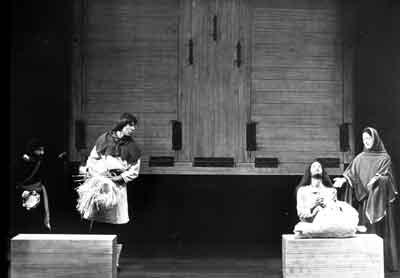
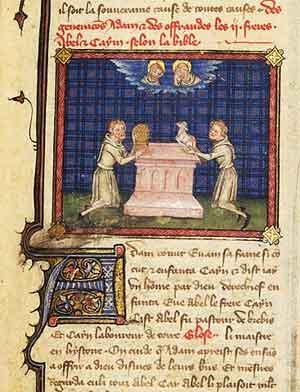
An additional change occurs in artistic treatments of the offering scene in modern times, with growing focus on the brothers' emotions rather than on their sacrifices.
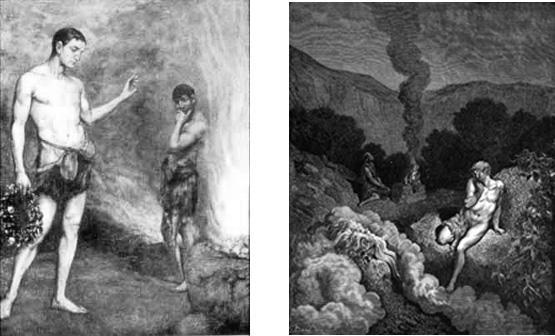
Hans Thoma, a German contemporary of Dore, depicts the one conversation between the two brothers. They have gone out to the fields to talk. "And Cain said to his brother Abel…." Perhaps Cain only needed to get things off his chest, to speak to someone, to confide in his brother? How did Abel react to his brother's pathetic confusion over his rejected offering? Did he look into Cain's eyes and see how distraught he was, how envious? Did he care? Abel did not yet understand how dangerous it is to be God's chosen one. His self-assurance knew no bounds.
(ח) וַיֹּ֥אמֶר קַ֖יִן אֶל־הֶ֣בֶל אָחִ֑יו וַֽיְהִי֙ בִּהְיוֹתָ֣ם בַּשָּׂדֶ֔ה וַיָּ֥קׇם קַ֛יִן אֶל־הֶ֥בֶל אָחִ֖יו וַיַּהַרְגֵֽהוּ׃
(8) Cain said to his brother Abel … and when they were in the field, Cain set upon his brother Abel and killed him.
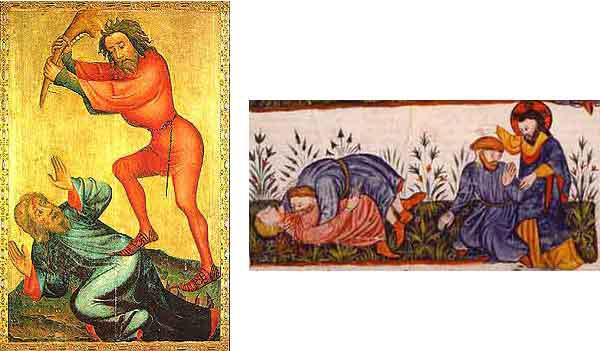
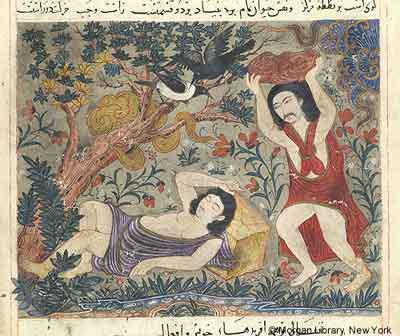
For example, in Meister Bertram's Grabow altarpiece, we see a satanic Cain, dressed in red, wielding the jawbone of an ass toward the coup de grace against an already bleeding Abel. His blue robe identifies him with Jesus, according to medieval artistic convention; his gestures, too, identify Abel as the ultimate martyr, beseeching mercy. Cain even tramples Abel, apparently in accordance with the literal interpretation of "vayakom Cain" "Cain stood up on his brother Abel and killed him" (v. 8). But the portrayal of this scene in the Duke of Alba's illustrated Bible is even more violent: Cain bites Abel neck! This unusual modus operandi is apparently based on the Zohar's account. And among the few Muslim depictions of the murder, a manuscript from 1300 in New York's Morgan Library has Cain about to crush the sleeping Abel with a large stone. This artist seems to have understood vayakom as "surprised," similarly to the interpretation of most Jewish commentators.
As already mentioned, until the Renaissance, most depictions of the murder were based on its christological interpretation as a prefiguration of Jesus' murder by the Jews. It is fascinating, therefore, to note the absence of this story from Michelangelo's Sistine ceiling. Apparently the theological interpretation did not attract Michelangelo. And while the story continues to appear after the Renaissance, its depiction has usually changed dramatically. It is no longer seen as a condemnation of the Jews, but as a metaphor for human-political struggle and competition. For example, Titian painted the two brothers as equally muscular and similarly clothed men.
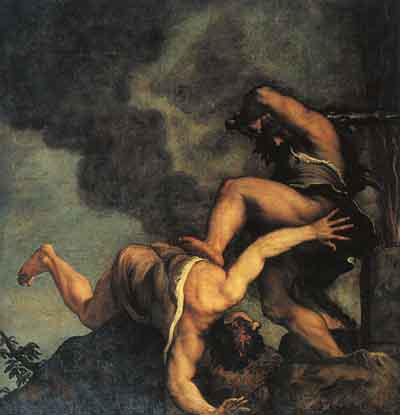
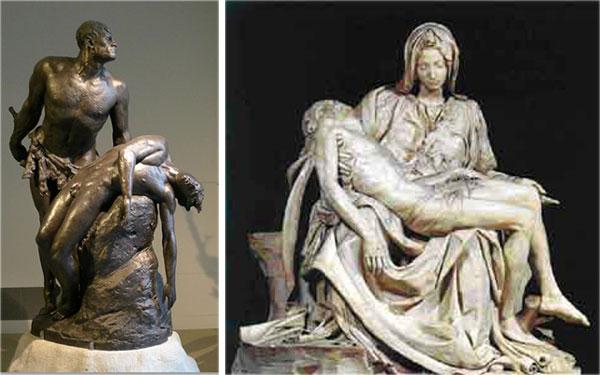
(ט) וַיֹּ֤אמֶר יהוה אֶל־הַ֔יִן אֵ֖י הֶ֣בֶל אָחִ֑יךָ וַיֹּ֙אמֶר֙ לֹ֣א יָדַ֔עְתִּי הֲשֹׁמֵ֥ר אָחִ֖י אָנֹֽכִי׃ (י) וַיֹּ֖אמֶר מֶ֣ה עָשִׂ֑יתָ ק֚וֹל דְּמֵ֣י אָחִ֔יךָ צֹעֲקִ֥ים אֵלַ֖י מִן־הָֽאֲדָמָֽה׃ (יא) וְעַתָּ֖ה אָר֣וּר אָ֑תָּה מִן־הָֽאֲדָמָה֙ אֲשֶׁ֣ר פָּצְתָ֣ה אֶת־פִּ֔יהָ לָקַ֛חַת אֶת־דְּמֵ֥י אָחִ֖יךָ מִיָּדֶֽךָ׃ (יב) כִּ֤י תַֽעֲבֹד֙ אֶת־הָ֣אֲדָמָ֔ה לֹֽא־תֹסֵ֥ף תֵּת־כֹּחָ֖הּ לָ֑ךְ נָ֥ע וָנָ֖ד תִּֽהְיֶ֥ה בָאָֽרֶץ׃ (יג) וַיֹּ֥אמֶר קַ֖יִן אֶל־יהוה גָּד֥וֹל עֲוֺנִ֖י מִנְּשֹֽׂא׃ (יד) הֵן֩ גֵּרַ֨שְׁתָּ אֹתִ֜י הַיּ֗וֹם מֵעַל֙ פְּנֵ֣י הָֽאֲדָמָ֔ה וּמִפָּנֶ֖יךָ אֶסָּתֵ֑ר וְהָיִ֜יתִי נָ֤ע וָנָד֙ בָּאָ֔רֶץ וְהָיָ֥ה כׇל־מֹצְאִ֖י יַֽהַרְגֵֽנִי׃ (טו) וַיֹּ֧אמֶר ל֣וֹ יהוה לָכֵן֙ כׇּל־הֹרֵ֣ג קַ֔יִן שִׁבְעָתַ֖יִם יֻקָּ֑ם וַיָּ֨שֶׂם יהוה לְקַ֙יִן֙ א֔וֹת לְבִלְתִּ֥י הַכּוֹת־אֹת֖וֹ כׇּל־מֹצְאֽוֹ׃ (טז) וַיֵּ֥צֵא קַ֖יִן מִלִּפְנֵ֣י יהוה וַיֵּ֥שֶׁב בְּאֶֽרֶץ־נ֖וֹד קִדְמַת־עֵֽדֶן׃
(9)יהוה said to Cain, “Where is your brother Abel?” And he said, “I do not know. Am I my brother’s keeper?” (10) “What have you done? Hark, your brother’s blood cries out to Me from the ground! (11) Therefore, you shall be more cursed than the ground, which opened its mouth to receive your brother’s blood from your hand. (12) If you till the soil, it shall no longer yield its strength to you. You shall become a ceaseless wanderer on earth.” (13) Cain said to יהוה, “My punishment is too great to bear! (14) Since You have banished me this day from the soil, and I must avoid Your presence and become a restless wanderer on earth—anyone who meets me may kill me!” (15)יהוה said to him, “I promise, if anyone kills Cain, sevenfold vengeance shall be exacted.” And יהוה put a mark on Cain, lest anyone who met him should kill him. (16) Cain left the presence of יהוה and settled in the land of Nod, east of Eden.

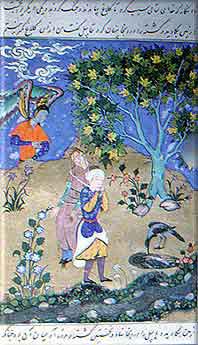
Stories of the Prophets,
Chester Beatty Library, 16th century
